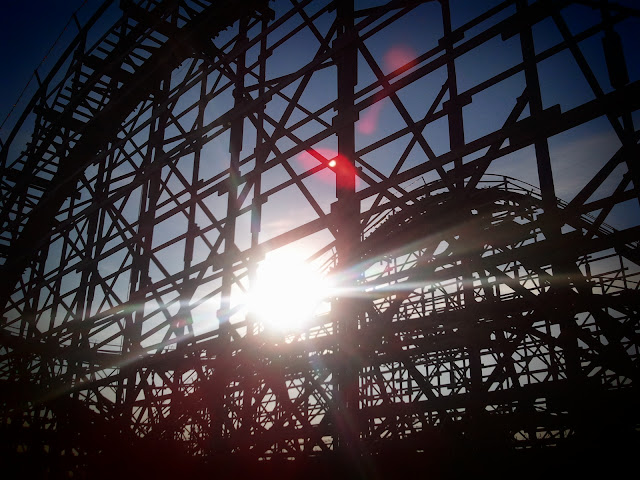The other Day Jeff and I had the AMAZING opportunity to see the historic Wooden Roller Coaster at Playland from a different perspective, the INSIDE!

This historic coaster was built in 1958 by Carl Phare and is one of the best wooden roller coasters in the world. It has a maximum drop height of 20 m (75 ft) and speeds of up to 76 km/h (47 mph). The American Coaster Enthusiasts organization declared The Wooden Roller Coaster the 21st 'Landmark' and 'Classic' roller coaster in the world, the only coaster to get both designations. At the time Carl Pahre was told the footprint was too small, the banked turns were too sharp and the drop was too steep for riders to endure. But, like Walt Disney, he did it anyway, dispite the critisisms of the nay sayers.We are so glad he did!!
 |
| The first drop. I love how you cannot even see it. This is an older photo, not one of ours. You can see how the boards here have been clad in white plastic strips. These have all fallen off or been removed as boards were replaced. |
This is truely one of the scariest roller coasters I have ever experienced, and definitely the most exciting. Feeling the tracks rumble under your feet and wondering if you will live to see another corn dog makes for a memorable experience.
Jeff says (after a summer working at the PNE and riding the coaster daily for weeks); If you sit in the front of the train, you'll be thrown out of your seat at the crest of the second hill. If you sit in the back of the train, you will be thrown out of your seat as the train begins down the plunge of the first hill. If you sit in the middle ( as Jeff does) you will remain comfortably in your seat, most of the time...
 |
| Hooray! |
 |
| From on the ride, the inside, the most exciting parts. Don't barf. |
 |
| Check out the inside curve, hold on to your hats. |
 |
| Inside, confusing and beautiful. |
 |
| Lots of camel-backs. |
 |
| I Love hidden treasures like this sad little monkey. |
 |
| "What...? An open entrance? Anyone could just walk right in..." We didn't of course, that would be wrong. |
 |
| The loading station, 1958 original, is getting new decking and railings before opening. |
 |
| The coaster in the park, taken from the locked front gates. this is the lift hill and the loading station. |
 |
| Closed for winter. Let me in. |
 |
| Winter in Vancouver, +7C and sunny. |
We just went to Hastings Park to check out the old fair buildings and walk through the sanctuary. It is a really beautiful place on a day like this, and kind of creepy as well, being a shuttered fair in the middle of winter. Its a cool place, and we're lucky it's in the middle of a public park we can go and wander around in freely. We were not expecting to see another open entrance and some very friendly employees. They allowed us in with close supervision to take a few shots. This was a dream come true for both of us. We've walked past the coaster a bunch of times talking about how cool it would be to see inside, though unlikely to ever happen. We learned all sorts of neat stuff from the workers, like how the structure of the coaster holds itself together. It is so well designed, it sits as one large piece, not thousands of rickety boards, and you could unbolt it from the ground, and it would just sit there, like a sculpture of amusement. We took our shots and left, thankful to the employees who could tell we were in heaven. "No one has a shot like this anywhere" one of them said. We went back to the sanctuary, sat on a bridge in the sun, and looked at out photos. eventually our heartrates went back no normal and the shock wore off.
We went to the fair in the middle of winter, and discovered a treasure. It was a great afternoon.
Lance and Jeff























